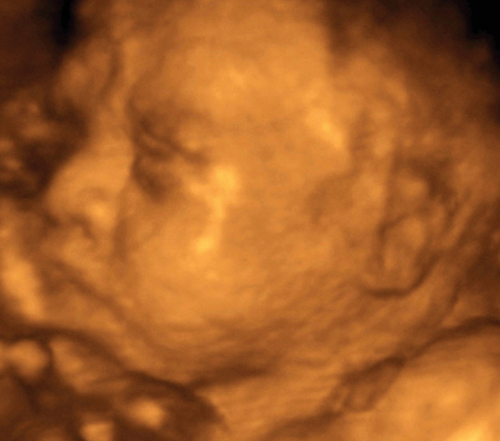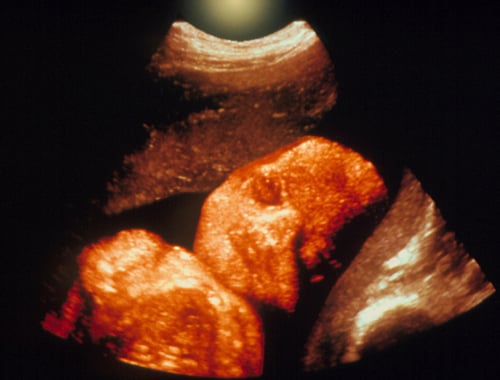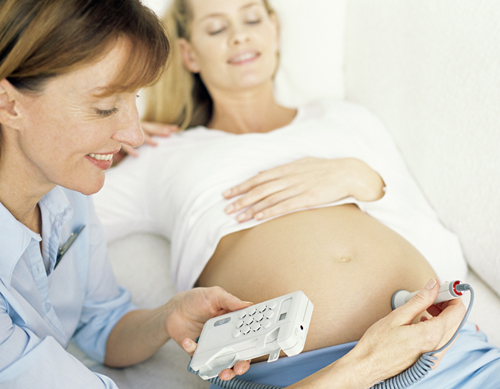You are 31 Weeks and 5 Days 58 days to go…
How your baby is positioned can affect your delivery, but there is plenty of time at this stage for things to change.
Your baby today
This image shows a furrowed brow and an open-eyed expression.
Just as the muscle tone in the limbs is strengthening, so the muscles of
the face are being used and tested. This can produce some unusual
expressions that do not necessarily reflect your baby’s emotions.

Each time you are examined your doctor will assess your baby’s lie and presentation.
Many babies are in the breech position earlier in the pregnancy, but
most turn into the head down position by the end of the pregnancy.
Still, breech births occur in about one in 25 full-term births. Between
32 and 37 weeks is the best time for your doctor to try to turn a breech
baby. This is because there is plenty of room for the baby to turn
around. After the 35th or 36th week, the baby is unlikely to change
position since there is less room for large maneuvers. If your baby is
breech, your doctor may try to turn the baby, a process called version
and she may recommend an extra ultrasound scan at 37–38 weeks of
pregnancy to check the baby’s position. It may be difficult to be
completely sure, on examination alone, whether the doctor is feeling the
baby’s bottom or head. If your baby is breech, your doctor may suggest a
cesarean delivery.
… Dads
Getting the balance right
Much of later pregnancy
involves your partner doing less than normal. This may range from doing
less exercise to not doing household chores. It may be challenging for
your partner to realize that she’s not able to do things as easily as
before and, to a certain extent, is less independent.
You can be a great help
to her in the final weeks of pregnancy, but be aware that there’s a fine
line between being supportive and being overly protective. Deep down
you may want to turn into “superman” and do everything, but it might
frustrate your partner if you become overly protective. Try to take the
lead from her and give her help as and when she needs it, as well as
space to do her own thing.

You are 31 Weeks and 6 Days 57 days to go…
If your third trimester coincides with the summer months, staying cool and comfortable can be a real challenge.
Your baby today
You can see from this image just how much amniotic fluid is
around your baby at this time. Ultrasound displays the fluid as black on
the screen. Sometimes there will be speckles within the fluid: these
represent skin and hair cells that are shed as your baby grows.

When the weather is hot,
your baby makes it sweltering! Keep yourself hydrated by drinking lots
of cool water. Consider carrying a spray bottle of water (keep it in the
fridge overnight so that it’s nice and cold next day) to spritz you
when you’re too hot.
Opt for sleeveless
clothing that is made of natural fabrics, such as linen and cotton,
which will help keep the air circulating. If you want to keep some or
all of your arms covered, wear short-sleeved jackets or cotton
cardigans. Wear a sun hat and sunglasses, especially if you’re in direct
sunlight for any length of time.
Opt for flip-flops or low-heeled sandals to let your feet breathe—these can also be a good option if your feet are swollen.
… Your baby
Listening to your baby’s heartbeat
From the very earliest stages of pregnancy,
your baby’s heart will be beating, and there can be nothing more
uplifting and reassuring than hearing this for yourself. Your doctor can
use a variety of instruments to hear your baby’s heartbeat, including a
stethoscope and a Doppler monitor (which uses ultrasound technology). A
baby’s heart beats between 120 and 160 times per minute (with slight
variations)—quite a few more than your own heartbeat, which is normally
under 100. The sole purpose of listening to the heartbeat is to ensure
that it falls within a normal range, and to reassure moms-to-be that all
is well. If there’s an unusual rhythm or the heartbeat speeds or slows
unexpectedly, your doctor can arrange for tests to confirm that all is
well. Some women feel that hearing their baby’s heartbeat helps the
bonding process in advance of the birth.

First hours and days
To help you prepare for what will follow the birth of your baby, here’s a few interesting facts you might like to know:
You may shake all over just after giving birth and don’t be concerned if you vomit, this is quite normal and nothing to worry about.
Newborn babies don’t always master breast-feeding immediately. Just like you, they need to practice.
After pains (the clamping sensation in your uterus when your baby nurses) can hurt almost as much as contractions.
The first time you urinate and defecate after giving birth can be uncomfortable.
You may feel very vulnerable, and in need of your own mom, in the first few days of parenthood.
Lochia (after-birth bleeding) can be a challenge at first, even if you’re using larger-sized sanitary pads.
Bonding with a newborn doesn’t always happen immediately for all mothers, but it’s worth the wait.